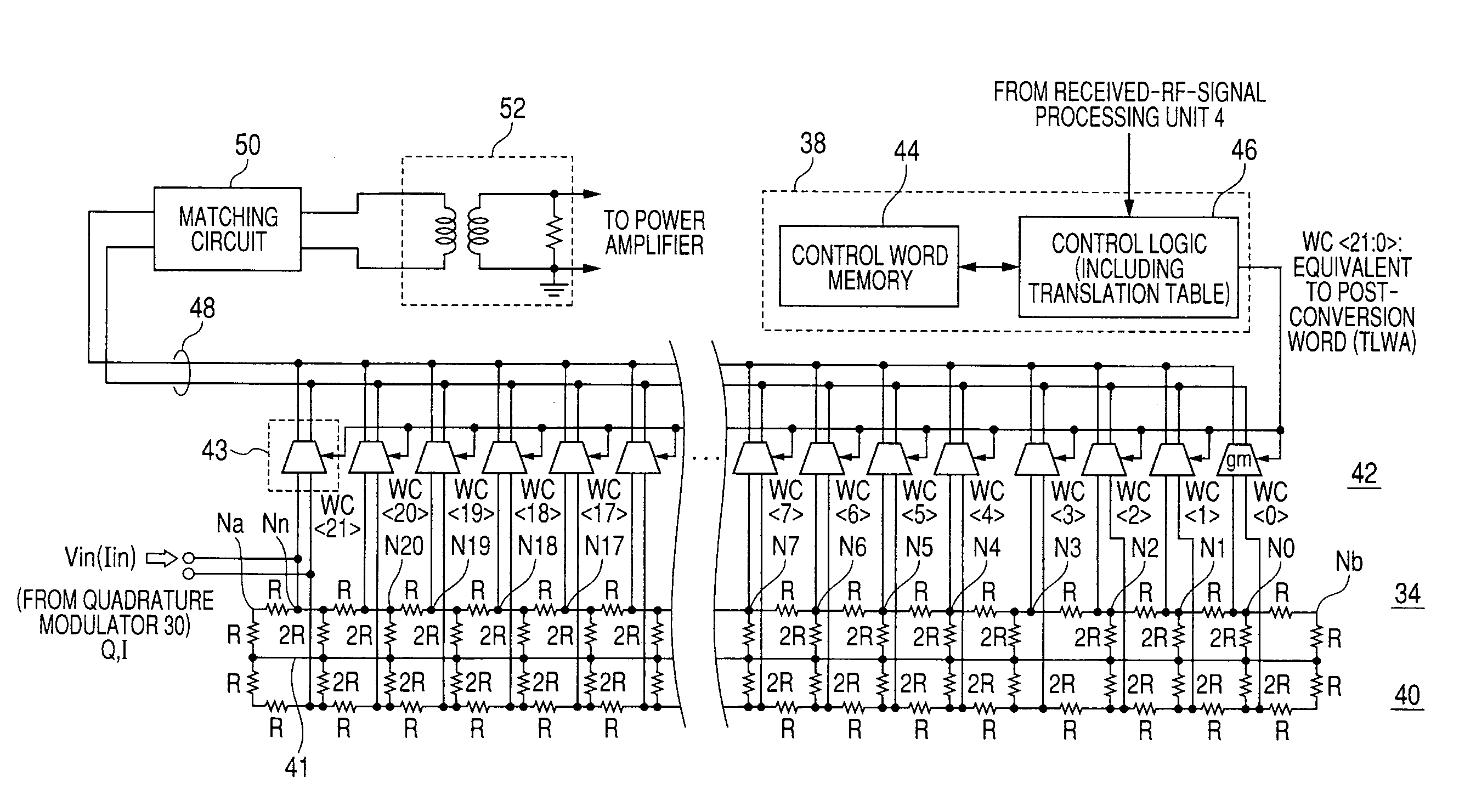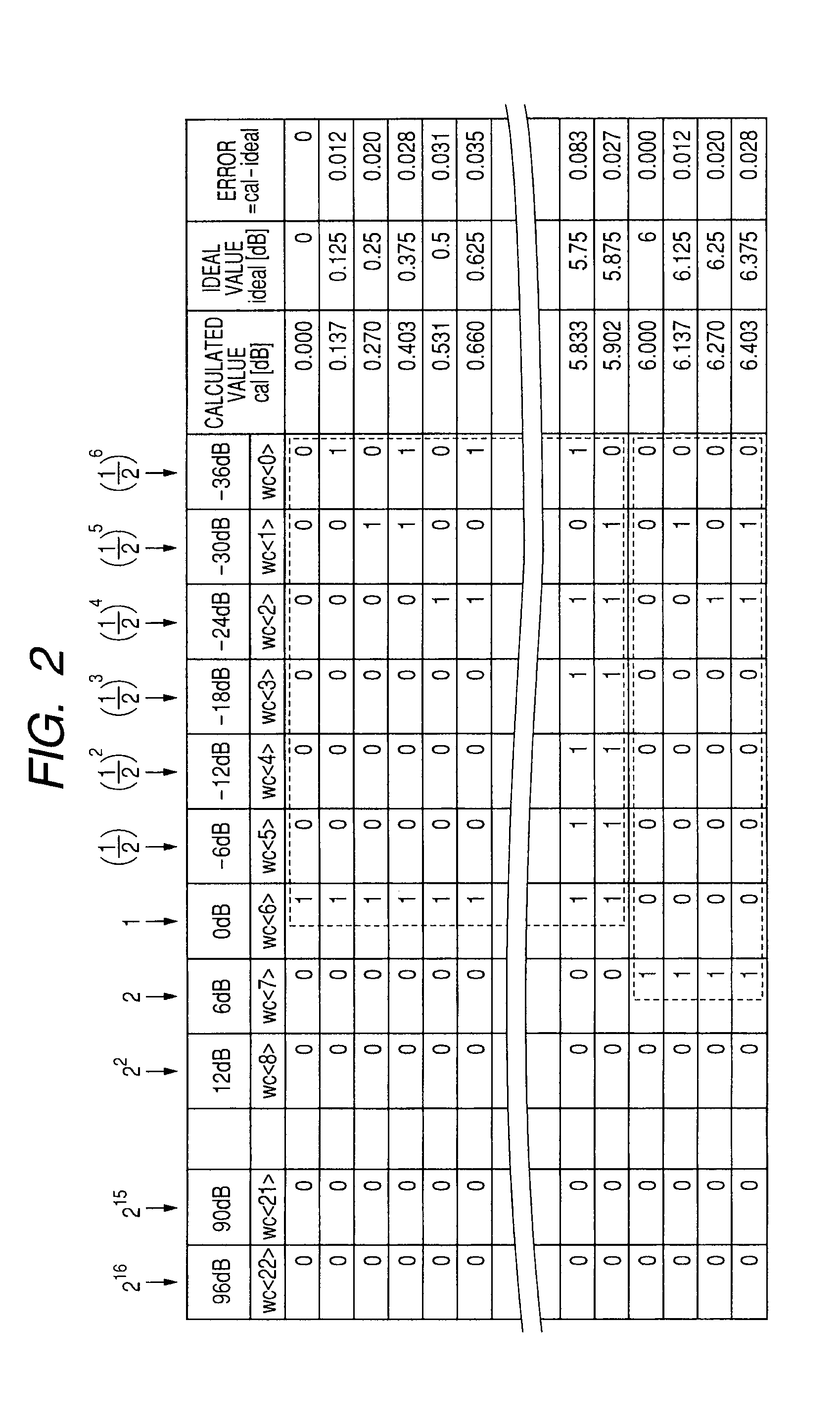Semiconductor device for signal amplification
a technology of signal amplification and semiconductor devices, which is applied in the direction of amplifier combinations, amplifiers with field-effect devices, gain control, etc., can solve the problems of poor power efficiency, large consumption current, and deterioration of gain controllability, so as to achieve fine resolution, reduce consumption current, and make the dynamic range high
- Summary
- Abstract
- Description
- Claims
- Application Information
AI Technical Summary
Benefits of technology
Problems solved by technology
Method used
Image
Examples
embodiment 1
[0053]FIG. 1 illustrates schematically an entire configuration of a mobile terminal including a semiconductor device for signal amplification according to Embodiment 1 of the present invention. In FIG. 1, the mobile terminal includes a reception path RX which receives and reproduces a signal supplied via an antenna 1, a transmitting path TX which transmits a signal / data via the antenna 1, and a transmitting / receiving duplex circuit 2 which couples the transmitting path TX and the reception path RX to the antenna 1. The present mobile terminal performs communication according to UMTS, employs an FDD system as the communications system, and performs transmission and reception in parallel on a full-duplex transmission system, by allocating different frequency bands to transmission and reception. The transmitting / receiving duplex circuit 2 performs transmission and reception in parallel to the antenna 1 using different frequency bands.
[0054]The transmitting / receiving duplex circuit 2 in...
embodiment 2
[0110]FIG. 8 illustrates a model of a delay circuit of the transconductance amplifier stage 43 and the R-2R ladder network. In FIG. 8, the configuration of three transconductance amplifier stages 43 and an R-2R ladder network which has the corresponding nodes is illustrated as an example. In the configuration illustrated in FIG. 8, a resistor R and a parasitic capacitance Cp are coupled to each of both inputs of the transconductance amplifier stage 43. Therefore, when voltage of the input signal is sequentially transmitted via a resistance element R of the R-2R ladder network, propagation delay of a signal occurs. When such propagation delay of the input signal occurs, phase fluctuation of a signal may occur in switching the transconductance amplifier stages.
[0111]FIG. 9 illustrates waveforms of the result that the source signal and the delayed signal are combined (added) in the delay model illustrated in FIG. 8. The voltage gain in the delay circuit is set to one. In FIG. 9, the ho...
embodiment 3
[0128]FIG. 12 illustrates schematically a configuration of a variable gain driver according to Embodiment 3 of the present invention. In FIG. 12, the variable gain driver 34 is different in configuration from the variable gain driver illustrated in FIG. 11 in the following points. That is, transconductance amplifiers 80, 81, and 82 of which the transconductance gm is enlarged every two times are provided in parallel with the input node Nn. The transconductance amplifier 80 has two times greater current supply capability than that of the transconductance amplifier stage 43, and is formed equivalently by two transconductance amplifier stages 43 coupled in parallel. The transconductance amplifier 81 has four times greater current supply capability than that of the transconductance amplifier stage 43, and is formed equivalently by four transconductance amplifier stages 43 coupled in parallel. The transconductance amplifier 82 has eight times greater current supply capability than that o...
PUM
 Login to View More
Login to View More Abstract
Description
Claims
Application Information
 Login to View More
Login to View More - R&D
- Intellectual Property
- Life Sciences
- Materials
- Tech Scout
- Unparalleled Data Quality
- Higher Quality Content
- 60% Fewer Hallucinations
Browse by: Latest US Patents, China's latest patents, Technical Efficacy Thesaurus, Application Domain, Technology Topic, Popular Technical Reports.
© 2025 PatSnap. All rights reserved.Legal|Privacy policy|Modern Slavery Act Transparency Statement|Sitemap|About US| Contact US: help@patsnap.com



